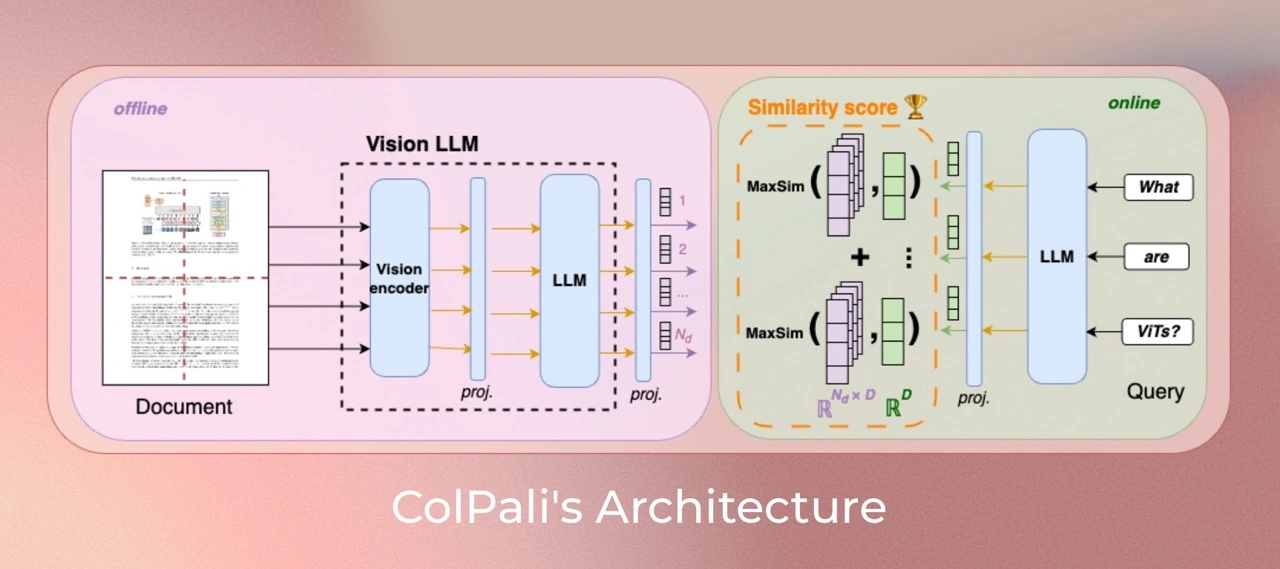[Model card] [ViDoRe Leaderboard] [Demo] [Blog Post]
Tip
For production usage in your RAG pipelines, we recommend using the byaldi package, which is a lightweight wrapper around the colpali-engine package developed by the author of the popular RAGatouille repostiory. 🐭
This repository contains the code used for training the vision retrievers in the ColPali: Efficient Document Retrieval with Vision Language Models paper. In particular, it contains the code for training the ColPali model, which is a vision retriever based on the ColBERT architecture and the PaliGemma model.
With our new model ColPali, we propose to leverage VLMs to construct efficient multi-vector embeddings in the visual space for document retrieval. By feeding the ViT output patches from PaliGemma-3B to a linear projection, we create a multi-vector representation of documents. We train the model to maximize the similarity between these document embeddings and the query embeddings, following the ColBERT method.
Using ColPali removes the need for potentially complex and brittle layout recognition and OCR pipelines with a single model that can take into account both the textual and visual content (layout, charts, ...) of a document.
| Model | Score on ViDoRe 🏆 | License | Comments | Currently supported |
|---|---|---|---|---|
| vidore/colpali | 81.3 | Gemma | • Based on google/paligemma-3b-mix-448.• Checkpoint used in the ColPali paper. |
❌ |
| vidore/colpali-v1.1 | 81.5 | Gemma | • Based on google/paligemma-3b-mix-448. |
✅ |
| vidore/colpali-v1.2 | 83.1 | Gemma | • Based on google/paligemma-3b-mix-448. |
✅ |
| vidore/colqwen2-v0.1 | 86.6 | Apache 2.0 | • Based on Qwen/Qwen2-VL-2B-Instruct.• Supports dynamic resolution. • Trained using 768 image patches per page. |
✅ |
We used Python 3.11.6 and PyTorch 2.2.2 to train and test our models, but the codebase is compatible with Python >=3.9 and recent PyTorch versions. To install the package, run:
pip install colpali-engineWarning
For ColPali versions above v1.0, make sure to install the colpali-engine package from source or with a version above v0.2.0.
import torch
from PIL import Image
from colpali_engine.models import ColPali, ColPaliProcessor
model_name = "vidore/colpali-v1.2"
model = ColPali.from_pretrained(
model_name,
torch_dtype=torch.bfloat16,
device_map="cuda:0", # or "mps" if on Apple Silicon
).eval()
processor = ColPaliProcessor.from_pretrained(model_name)
# Your inputs
images = [
Image.new("RGB", (32, 32), color="white"),
Image.new("RGB", (16, 16), color="black"),
]
queries = [
"Is attention really all you need?",
"Are Benjamin, Antoine, Merve, and Jo best friends?",
]
# Process the inputs
batch_images = processor.process_images(images).to(model.device)
batch_queries = processor.process_queries(queries).to(model.device)
# Forward pass
with torch.no_grad():
image_embeddings = model(**batch_images)
query_embeddings = model(**batch_queries)
scores = processor.score_multi_vector(query_embeddings, image_embeddings)You can find an example here. If you need an indexing system, we recommend using byaldi - RAGatouille's little sister 🐭 - which share a similar API and leverages our colpali-engine package.
To benchmark ColPali to reproduce the results on the ViDoRe leaderboard, it is recommended to use the vidore-benchmark package.
To keep a lightweight repository, only the essential packages were installed. In particular, you must specify the dependencies to use the training script for ColPali. You can do this using the following command:
pip install "colpali-engine[train]"All the model configs used can be found in scripts/configs/ and rely on the configue package for straightforward configuration. They should be used with the train_colbert.py script.
USE_LOCAL_DATASET=0 python scripts/train/train_colbert.py scripts/configs/pali/train_colpali_docmatix_hardneg_model.yamlor using accelerate:
accelerate launch scripts/train/train_colbert.py scripts/configs/pali/train_colpali_docmatix_hardneg_model.yamlsbatch --nodes=1 --cpus-per-task=16 --mem-per-cpu=32GB --time=20:00:00 --gres=gpu:1 -p gpua100 --job-name=colidefics --output=colidefics.out --error=colidefics.err --wrap="accelerate launch scripts/train/train_colbert.py scripts/configs/pali/train_colpali_docmatix_hardneg_model.yaml"
sbatch --nodes=1 --time=5:00:00 -A cad15443 --gres=gpu:8 --constraint=MI250 --job-name=colpali --wrap="python scripts/train/train_colbert.py scripts/configs/pali/train_colpali_docmatix_hardneg_model.yaml"To reproduce the results from the paper, you should checkout to the v0.1.1 tag or install the corresponding colpali-engine package release using:
pip install colpali-engine==0.1.1ColPali: Efficient Document Retrieval with Vision Language Models
Authors: Manuel Faysse*, Hugues Sibille*, Tony Wu*, Bilel Omrani, Gautier Viaud, Céline Hudelot, Pierre Colombo (* denotes equal contribution)
@misc{faysse2024colpaliefficientdocumentretrieval,
title={ColPali: Efficient Document Retrieval with Vision Language Models},
author={Manuel Faysse and Hugues Sibille and Tony Wu and Bilel Omrani and Gautier Viaud and Céline Hudelot and Pierre Colombo},
year={2024},
eprint={2407.01449},
archivePrefix={arXiv},
primaryClass={cs.IR},
url={https://arxiv.org/abs/2407.01449},
}





